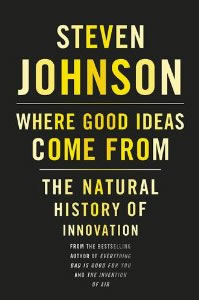 Steven Johnson examines a wide number of inventions that have arisen over a large period of time and attempts to determine (where possible) how exactly did the invention arise. His findings show that good ideas seldom arose from the workbench of a solitary thinker/inventor but more likely from a person who actively networks with a wide variety of peers.
Steven Johnson examines a wide number of inventions that have arisen over a large period of time and attempts to determine (where possible) how exactly did the invention arise. His findings show that good ideas seldom arose from the workbench of a solitary thinker/inventor but more likely from a person who actively networks with a wide variety of peers.
In short, first: actively look to solve a problem. You need to understand the domain of the problem, and attempt the simple solutions first.
Next, give your brain time to ruminate on the problem. During this phase, your brain is trying to match the problem to similar things that isn’t immediately obvious. Ideally, record all your thinking (withholding judgment from your thoughts). In the thinking are often the seeds for your solution.
Then, make sure to immerse yourself with other interesting people. Share your problem with them to get their different perspectives and spur on new observations for your problem. Often, your problem has already been solved in some way in a different domain. By exposing yourself to diverse peers, you get more brains seeing your problem’s similarities.
The book ends with these wise words:
“…Go for a walk, cultivate hunches, write everything down, but keep your folder messy; embrace serendipity; make generative mistakes; take on multiple hobbies; frequent coffeehouses and other liquid networks; follow the links; let others build on your ideas; borrow, recycle, reinvent. Build a tangled bank.”
Bonus: Steven Johnson’s TED presentation:
Second bonus: Steven Johnson’s presentation as an animated movie:
Aside: This book is a great companion to the book The Power Of Pull (John Hagel III, John Seely Brown, and Lang Davison).